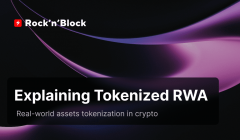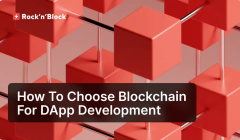What Exactly Yield Farming Is | DeFi Yield Farming Explained
12 Nov 2021Welcome to the world of DeFi yield farming development! In this article, we'll unravel the intricacies of this innovative practice, from its basics to its dynamic landscape and key projects.
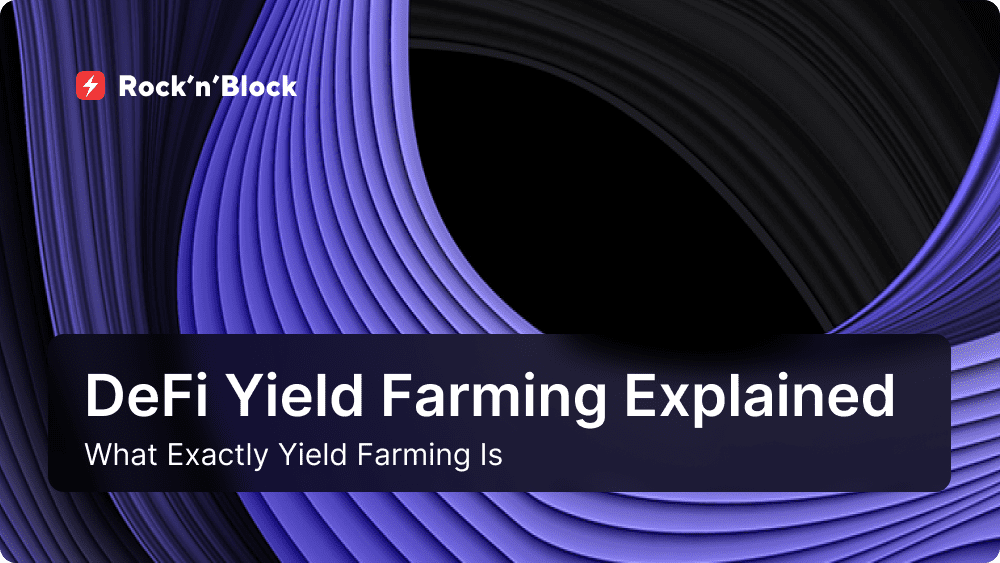
Table of Contents:
-
What is Yield Farming?
-
Why Yield Farming Development Matters
-
Exploring Yield Farming Types in The DeFi Landscape
-
Key Components of Yield Farming Development
-
How DeFi Yield Farming Works
-
Navigating the Risks of Yield Farming in DeFi
-
Exploring Key Projects in the Yield Farming Landscape
-
Conclusion
What is Yield Farming?
In the fast-paced realm of DeFi landscape, yield farming development has emerged as a transformative concept that has captured the imagination of crypto enthusiasts worldwide. But what exactly is yield farming, and why is it so significant in the DeFi projects landscape? Let’s explore what yield farming is, trace its origins, and explore the key problems it aims to solve.

Defining Yield Farming
Yield farming development, often referred to as liquidity mining, is a DeFi strategy that allows crypto holders to earn passive income by providing liquidity to various DeFi protocols and platforms. In simpler terms, it involves locking up your cryptocurrencies in smart contracts to generate additional tokens or rewards over time.
The process revolves around participating in liquidity pools, which are at the heart of DeFi. These pools facilitate activities such as lending, trading, or borrowing, and they rely on the contribution of users who lock their assets to provide liquidity. In return, these liquidity providers receive rewards in the form of additional tokens, interest, transaction fees, or a share of the platform's income.
The Emergence of Yield Farming
Yield farming protocols didn't just appear overnight. Its emergence can be traced back to the evolution of DeFi and the desire to solve fundamental issues within the ecosystem.
1. Liquidity Challenges: DeFi platforms faced liquidity challenges, making it difficult for users to access liquidity for trading or borrowing. Yield farming development emerged as a solution by incentivizing users to provide liquidity to these platforms, thus addressing this crucial issue.
2. Token Distribution: Many DeFi projects needed a mechanism to distribute their native Defi tokens in a decentralized and fair manner. Yield farming protocols development became a method for distributing tokens widely and encouraging active participation in the DeFi ecosystem.
3. Community Engagement: By offering rewards, DeFi platforms encouraged users to actively engage in governance and decision-making processes. This fostered a sense of ownership and commitment among the community, strengthening the ecosystem's decentralized nature.
Key Problems Yield Farming Solves
Yield farming development serves as a solution to various problems in the DeFi space:
1. Liquidity Provision: Yield farming development provides the much-needed liquidity for DeFi platforms. Users locking their assets in liquidity pools ensure a steady flow of assets, benefiting traders, borrowers, and the platforms themselves.
2. Incentivizing Participation: By offering rewards, DeFi projects motivate users to participate actively in their ecosystem. This incentivization stimulates growth and competitiveness within the DeFi landscape.
3. Token Distribution: Yield farming development allows efficient distribution of a project's native tokens, helping to decentralize and engage a broad and diverse community of token holders.
4. Earning Passive Income: Yield farming platforms development offers a way for users to generate passive income on their crypto assets, enabling them to earn while holding their preferred tokens.
Yield farming development is not just a lucrative financial opportunity; it's a fundamental component of the DeFi ecosystem, designed to address the liquidity, token distribution, and community engagement challenges that have historically plagued the space. While it brings exciting possibilities, it's important for participants to be mindful of the associated risks and conduct thorough research before engaging in yield farming activities. Yield farming exemplifies the innovative spirit of DeFi and continues to play a pivotal role in reshaping the future of finance.
Why Yield Farming Development Matters
What makes yield farming development matter in the DeFi landscape? Let’s explore the significance of yield farming development and why it plays a pivotal role in the world of decentralized finance.

Enhancing Liquidity in DeFi
One of the most critical issues that DeFi platforms face is the need for liquidity. Liquidity is the lifeblood of any financial ecosystem, and DeFi is no exception. Yield farming development addresses this challenge by incentivizing users to provide liquidity to these platforms. Users lock up their assets in liquidity pools, ensuring a steady flow of assets, which is vital for the smooth operation of DeFi services. This enhanced liquidity benefits traders, borrowers, and the DeFi platforms themselves.
Incentivizing Participation
Yield farming dApps are a powerful tool for incentivizing user participation within the DeFi ecosystem. By offering rewards in the form of additional tokens, interest, or a share of transaction fees, DeFi projects development encourages users to actively engage with their platforms. These incentives can be the spark that ignites the DeFi fire, driving user engagement, platform growth, and competitiveness. In essence, yield farming development is a catalyst for active involvement within the DeFi community.
Token Distribution and Decentralization
Yield farming development serves as a unique method for distributing a project's native tokens to a wide and diverse audience. This approach ensures a decentralized distribution of tokens, which is a fundamental aspect of DeFi. A wide distribution reduces the risk of centralization and promotes community engagement. It allows a broad range of users to become stakeholders and influence the future of the project. Yield farming development, thus, helps maintain the core principle of decentralization within DeFi.
Empowering Passive Income Generation
For users, yield farming development offers a straightforward yet potent means of generating passive income. By staking their tokens or providing liquidity to DeFi platforms, users can earn rewards on their assets. This encourages individuals to make their crypto holdings work for them, ensuring that their investments remain active and potentially profitable even when not actively trading or participating in the ecosystem.
The Power of Yield Farming Development
In the rapidly evolving world of DeFi, yield farming development is a critical component. It enhances liquidity, incentivizes participation, promotes token distribution, and empowers passive income generation. It plays a pivotal role in addressing the fundamental challenges faced by DeFi platforms, making it easier for users to access liquidity, actively engage in platform governance, and earn rewards. It is, in many ways, the engine that keeps the DeFi ecosystem running smoothly.
Exploring Yield Farming Types in The DeFi Landscape
Yield farming development, a cornerstone of the DeFi space, is not a one-size-fits-all concept. Within this dynamic ecosystem, different yield farming types have emerged, each with its own unique features and opportunities.

Let's delve into these distinct yield farming types, shedding light on the diversity and innovation within DeFi.
1. Liquidity Provision Yield Farming
Liquidity provision yield farming development is the most common and fundamental type. In this approach, users provide liquidity to decentralized exchanges (DEXs) or lending platforms by depositing their assets into liquidity pools. These pools facilitate trading, lending, or borrowing on the platform. Users are rewarded with fees, interest, or additional tokens for their participation.
Key Characteristics of Liquidity Provision Yield Farming development:
-
Users provide liquidity to DeFi platforms.
-
They earn rewards in the form of fees or tokens.
-
Common platforms: Uniswap, SushiSwap, Compound.
Advantages of Liquidity Provision Yield Farming development:
-
Passive income through liquidity provision.
-
Increases liquidity on DeFi platforms, benefiting all users.
-
Opportunities for compounding rewards.
2. Governance Token Yield Farming
Governance token yield farming development focuses on participating in the governance of DeFi protocols. Users stake their tokens in governance contracts to have a say in decision-making processes, such as proposing and voting on protocol changes. In return, they receive governance tokens that grant voting rights.
Key Characteristics of Governance Token Yield Farming development:
-
Users stake tokens to participate in governance.
-
Earn governance tokens for voting and proposals.
-
Common platforms: Compound, Aave, Yearn.Finance.
Advantages of Governance Token Yield Farming development:
-
Active involvement in shaping DeFi protocols.
-
Influence over the platform's direction and future.
-
Opportunities for token appreciation.
3. Yield Farming Aggregators
Yield farming aggregator development is all about maximizing returns by moving assets between different yield farming platforms and protocols. Users employ advanced strategies that automatically switch their assets to the platform offering the highest yield. This approach requires a more active and vigilant approach.
Key Characteristics of Yield Farming Aggregators development:
-
Utilizes automation to find the best yields.
-
Users actively manage their assets across platforms.
-
Common platforms: Yearn.Finance, Harvest Finance, AutoFarm.
Advantages of Yield Farming Aggregators development:
-
Maximizes yield by chasing the most profitable opportunities.
-
Aggregates returns from multiple DeFi protocols.
-
Optimizes asset allocation for users.
4. Impermanent Loss Mitigation Farming
Impermanent loss is a concern for liquidity providers, as it refers to potential losses incurred when providing liquidity in volatile markets. Impermanent loss mitigation farming aims to minimize these losses. Users employ strategies and protocols designed to offset the impact of impermanent loss, often in return for rewards.
Key Characteristics of Impermanent Loss Mitigation Farming:
-
Focuses on reducing losses for liquidity providers.
-
Utilizes strategies and protocols to mitigate impermanent loss.
-
Common platforms: Hegic, KeeperDAO, Impermax.
Advantages of Impermanent Loss Mitigation Farming:
-
Reduces risk for liquidity providers.
-
Provides an alternative for those concerned about impermanent loss.
-
Opportunities for offsetting losses with rewards.
Summing Up DeFi Yield Farming Development Types
DeFi yield farming has evolved far beyond a simple liquidity provision strategy. With various yield farming types, users can choose the approach that aligns with their risk tolerance and financial goals. As the DeFi landscape continues to innovate, these diverse opportunities for passive income and active participation provide ample room for growth and exploration within the world of decentralized finance. However, it's essential to conduct thorough research and stay informed about the risks associated with each yield farming type before diving in. Yield farming development exemplifies the versatility and adaptability of DeFi, and it remains an exciting and integral part of the ever-evolving financial ecosystem.
Key Components of Yield Farming Development:
Yield farming, an intricate mechanism within DeFi, has revolutionized the way we interact with our crypto assets. But what are the fundamental components that power yield farming development?

Let’s delve into the key elements that make yield farming work and explore the intricacies of this innovative DeFi strategy.
1. Liquidity Pools
Liquidity pools are the heart and soul of yield farming development. These pools are smart contracts that facilitate the exchange of assets within the DeFi ecosystem. Users provide liquidity to these pools by depositing their cryptocurrencies. This liquidity enables DeFi platforms to offer services like trading, lending, and borrowing. The pool's assets are used to execute these transactions, and users receive rewards for their contributions to liquidity.
2. Automated Market Makers (AMMs)
AMMs is a decentralized exchange protocol that plays a pivotal role in yield farming development. They use mathematical algorithms to determine the price of assets in the liquidity pool. AMM based DEXes like Uniswap and SushiSwap are popular choices in yield farming development, and their smart contracts execute trades efficiently, ensuring fair and decentralized price discovery.
3. Liquidity Provider (LP) Tokens
When users provide liquidity to a pool, they receive Liquidity Provider (LP) tokens in return. These tokens represent the user's share in the pool's liquidity. LP tokens are a testament to the user's participation and serve as a claim to a portion of the rewards generated by the pool. Users can often stake or lock their LP tokens to earn additional rewards.
4. Yield Aggregators
Yield farming can be an intricate process, involving the management of assets across different DeFi protocols to maximize returns. This is where yield aggregators come into play. These are automated tools or platforms that help users identify and shift their assets to the platforms with the highest yields. Yield aggregators optimize asset allocation, helping users make the most of their yield farming strategies.
5. Governance Tokens
Governance tokens grant users the ability to participate in the decision-making processes of a DeFi platform. By holding and staking governance tokens, users can vote on proposals, changes, and upgrades to the platform's smart contracts and policies. These tokens not only empower users but also foster a sense of ownership within the DeFi community.
6. Yield Farming Smart Contracts
Smart contracts are the backbone of DeFi and yield farming development. These self-executing contracts ensure the transparency and automation of yield farming protocol. They dictate the rules, terms, and conditions of the liquidity pools, asset management, and reward distribution. Secure and well-audited ield farming smart contracts are crucial to the reliability and success of yield farming development.
A Complex Yet Rewarding Ecosystem
Yield farming is a complex yet rewarding ecosystem that relies on several key components working in harmony. Liquidity pools, AMMs, LP tokens, yield aggregators development, governance tokens, and secure smart contracts collectively create the engine that powers yield farming development. This system allows users to actively engage with their crypto assets, providing liquidity, earning rewards, and actively participating in the DeFi ecosystem. However, it's essential to navigate this landscape with care, conduct due diligence, and be aware of the potential risks and rewards associated with yield farming. It exemplifies the innovation and adaptability of DeFi, offering a dynamic and exciting journey for those willing to explore it wisely.
How DeFi Yield Farming Works
How does yield farming work, and what are the mechanics behind this powerful DeFi strategy?
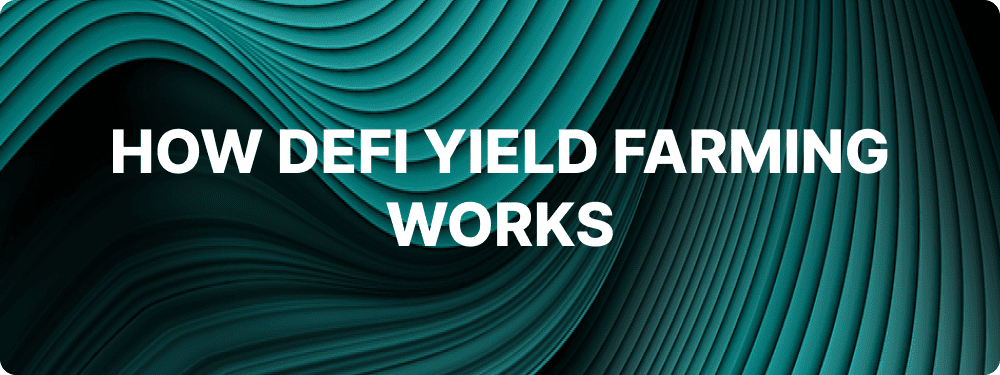
Let’s demystify the process and explore the inner workings of DeFi yield farming development.
1. Selecting a DeFi Protocol
Yield farming development begins with selecting a DeFi protocol or platform to participate in. This choice is crucial, as it defines the terms and conditions of your yield farming journey. These protocols can take various forms, such as decentralized exchanges (DEXs), lending platforms, or liquidity pools.
2. Providing Liquidity
Once you've chosen a DeFi protocol, you'll need to provide liquidity to it. This is typically done by depositing your assets, which could be cryptocurrencies or tokens, into a liquidity pool. These pools are fundamental to the DeFi ecosystem as they facilitate a wide range of activities, including trading, lending, and borrowing. When you provide liquidity to these pools, you're contributing to the availability of assets for these activities.
3. Receiving LP Tokens
In return for providing liquidity to the pool, you receive LP (Liquidity Provider) tokens. These tokens represent your share of the pool and your contribution to the liquidity. LP tokens serve as a testament to your participation and give you the right to a portion of the rewards generated by the pool.
4. Earning Rewards
Rewards in yield farming are typically provided in the form of additional tokens, interest, or a share of transaction fees. The specifics of the rewards depend on the DeFi protocol you're participating in. For instance, in an AMM like Uniswap, you might earn a portion of the trading fees generated by the platform. In a lending protocol like Aave, you could receive interest on the assets you've deposited.
5. Optimizing Returns
Yield farmers often explore opportunities to maximize their returns. This might involve moving their assets between different DeFi protocols or yield farming platforms to chase the most profitable opportunities. Yield aggregators development, automated tools or platforms that manage these strategies, help users automatically shift their assets to the platforms with the highest yields, streamlining the process.
Navigating the Risks in DeFi with Yield Farming
Yield farming in the DeFi projects landscape has captivated the attention of crypto enthusiasts due to its potential for high returns. However, with great rewards come great risks. In this part, we'll explore the potential risks associated with yield farming development and why it's crucial to tread cautiously within this exciting but volatile landscape.
1. Impermanent Loss
Impermanent loss is a term that often strikes fear into the hearts of liquidity providers in yield farming. It occurs when the price of the assets in a liquidity pool changes compared to when the liquidity was initially provided. In other words, as the value of your assets fluctuates, you may experience a loss when compared to simply holding those assets.
Risk Mitigation: Understand the concept of impermanent loss, conduct careful research, and consider only providing liquidity when you are comfortable with the potential losses.
2. Smart Contract Vulnerabilities
The DeFi ecosystem relies heavily on smart contracts. While these contracts are designed to automate processes and ensure transparency, they can also be vulnerable to exploitation. Hackers have targeted smart contracts in the past, leading to significant losses for users. Malicious actors can find vulnerabilities and exploit them to steal funds or manipulate DeFi protocols.
Risk Mitigation: Choose platforms and yield farming opportunities with well-audited and secure smart contracts. Stay informed about security best practices and the latest developments in the DeFi security landscape.
3. Market Volatility
Yield farming platforms development often involves exposure to different cryptocurrencies or tokens. The crypto market is known for its high volatility, where prices can experience rapid and significant fluctuations. Market volatility can impact the value of the assets you hold and the rewards you earn.
Risk Mitigation: Diversify your holdings, conduct thorough research, and consider risk management strategies. Be prepared for the possibility of significant price swings.
4. Project Risks
Yield farming development often involves participation in DeFi projects, some of which may be relatively new or unproven. The risk of project failure or exit scams exists, where the project creators may disappear or cease operations, leaving participants with losses.
Risk Mitigation: Prioritize well-established and reputable DeFi projects with transparent teams and a track record of success. Be cautious when participating in newer or less-known projects.
5. Slippage and High Gas Fees
Yield farming development often requires transactions on the Ethereum network or other blockchain platforms. During periods of high demand, gas fees can soar, making transactions expensive. Additionally, slippage, the difference between the expected and actual price of assets in a trade, can affect the efficiency of your yield farming strategies.
Risk Mitigation: Plan your transactions carefully, monitor gas fees, and consider less congested times to minimize costs.
Proceeding with Caution
Yield farming is an exciting and potentially lucrative DeFi strategy, but it is not without its risks. To navigate this landscape successfully, it's essential to approach yield farming with caution, conduct thorough research, and be prepared for potential challenges. Understanding impermanent loss, staying vigilant against smart contract vulnerabilities, managing market volatility, and carefully selecting DeFi projects are all part of a prudent yield farming strategy. While the rewards can be substantial, it's crucial to prioritize safety and risk management when participating in yield farming opportunities.
Exploring Key Projects in the Yield Farming Landscape
Yield farming development, a dynamic and innovative concept within DeFi, has witnessed the rise of numerous projects seeking to redefine how crypto enthusiasts interact with their assets.
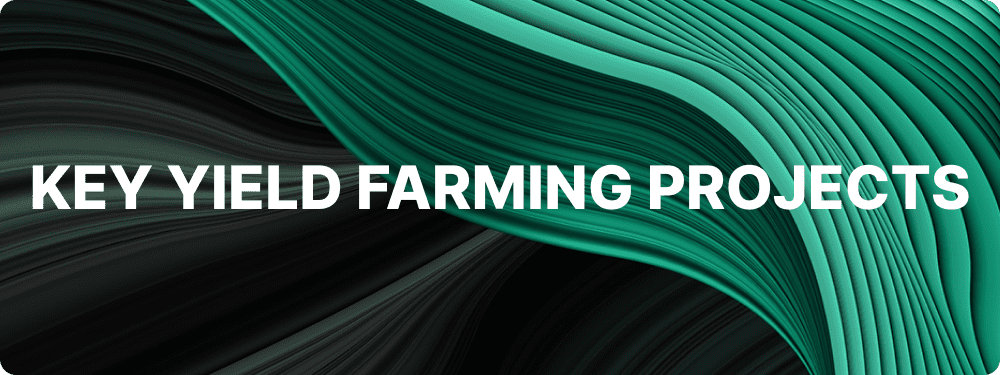
Let’s explore some of the key projects that have played a pivotal role in shaping the yield farming development landscape and delve into the success stories that have made them stand out.
1. Uniswap
Uniswap is often regarded as one of the pioneers of decentralized exchanges and automated market makers (AMMs). It introduced a groundbreaking concept that allowed users to provide liquidity to liquidity pools in exchange for rewards. Uniswap's UNI token has become synonymous with DeFi, and the platform's innovative approach to trading and liquidity provision has set a benchmark for the industry, encouraging others to keep up with the latest protocol updates and creating DEXes like Uniswap.
2. Aave
Aave, a decentralized lending and borrowing protocol, has gained prominence for its role in yield farming development. Users can deposit their assets into Aave's liquidity pools to earn interest and rewards. Aave's governance token, AAVE, has allowed users to participate in the platform's decision-making processes, creating a sense of community and ownership.
3. Compound
Compound is another notable project that has redefined borrowing and lending within DeFi. Users can provide liquidity by depositing assets, and in return, they earn interest and COMP tokens. Compound's governance model has empowered users to shape the platform's policies and distribution of assets.
4. Yearn.Finance
Yearn.Finance is a yield aggregator that seeks to optimize returns for users. Its suite of products and strategies automatically reallocates assets to the platforms with the highest yields, streamlining the yield farming process. The project has grown rapidly and showcases the potential of automated yield farming strategies.
5. SushiSwap
SushiSwap emerged as a formidable competitor to Uniswap, offering users the opportunity to provide liquidity in exchange for rewards and its governance token, SUSHI. The project's unique features, such as yield farming pools and innovative strategies, have helped it make a mark in the DeFi landscape.
Summing up Key Projects in the Yield Farming Landscape
These key projects have not only reshaped the yield farming landscape but also provided users with opportunities to earn rewards, participate in governance, and engage actively in the DeFi ecosystem. Their success stories exemplify the potential of DeFi to empower users and create decentralized financial systems.
Uniswap's UNI token airdrop, Aave's governance participation, Compound's liquidity provision, Yearn.Finance's automated strategies, and SushiSwap's competitive features showcase the diversity of opportunities within yield farming.
These projects have demonstrated the power of innovation and the ability to create value in the DeFi space, but it's crucial to approach them with caution. Conducting thorough research and understanding the risks and rewards associated with each project is vital for those looking to explore the exciting world of yield farming.
Conclusion
In conclusion, DeFi yield farming development is a captivating and ever-evolving domain within the cryptocurrency and blockchain landscape. This article has delved into the very essence of yield farming, explaining its core concepts, the importance of its development, the various types that make it diverse, and the key components that keep it running smoothly. We've also explored the mechanics of how yield farming works, the potential risks involved, and the notable projects that have left an indelible mark on this dynamic space.
Yield farming development, at its core, is about empowering crypto enthusiasts to participate actively in the DeFi ecosystem. It offers opportunities to earn rewards, shape the future of platforms, and explore innovative strategies. However, it's equally vital to recognize the associated risks, conduct thorough research, and embrace risk management strategies.
As the DeFi landscape continues to evolve, yield farming development remains a cornerstone of innovation and exploration. It represents the adaptability, creativity, and democratization of finance that DeFi embodies. Whether you're an experienced DeFi enthusiast or just stepping into this exciting realm, yield farming has something to offer for everyone, opening doors to a financial future that is truly decentralized and inclusive.
We ❤️ Development
Follow us on social media to receive the hottest blockchain development updates
Crunchbase ⚡️ Twitter ⚡️ Telegram ⚡️ LinkedIn ⚡️ Facebook ⚡️ Zupyak ⚡️ Quora ⚡️ Reddit



